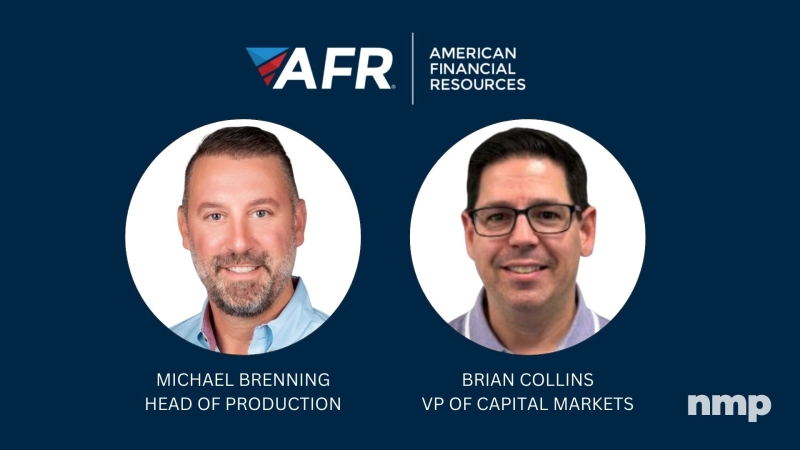Advertisement
NMP Mortgage Professional of the Month: Chad J. Jampedro, COO, GSF Mortgage Corporation

Each month, National Mortgage Professional Magazine will focus on one of the industry's top players in our "Mortgage Professional of the Month" feature. This month, we had a chance to chat with Chad Jampedro, managing vice president of GSF Mortgage Corporation. Chad got his start in the mortgage industry in 1997 with National City Bank. A graduate of Washington & Jefferson College in Washington, Pa., Chad started off working in collections as a loss mitigation representative, helping create forbearance plans for customers. In 2001, he joined GSF Mortgage Corporation as a loan officer, working his way up the corporate ladder at GSF as vice president of marketing, manager of correspondent pricing and product development, to his current role with GSF as chief operating officer. Chad oversees the day-to-day functions of the company in his position as COO, providing guidance and leadership to the company’s branches. Our readers are encouraged to contact us by e-mail at [email protected] for consideration in being featured in a future "Mortgage Professional of the Month" column.
How did you get your start in the mortgage industry?
I began working for National City Bank in 1997. This was my first job in the industry. From a corporate standpoint, it was quite overwhelming transitioning from making pizzas, to working in a corporate atmosphere. I spent a tremendous amount of time learning the protocols, policies and procedures that drive corporate America. At National City, I started in the loss mitigation loan collections department, collecting delinquent loans, working from an automated system. The system would display the borrower’s information regarding specific transactions. I very quickly realized that there was a human side to each transaction. The people on the other end of the line may have been delinquent with payments, but they are also dealing with various circumstances stemming from divorces, deaths in the family, job loss, etc. At GSF, we realize that we are building lasting connections with our clients. While one of our goals is to earn repeat and referral business, first and foremost, we strive to be a resource our customers can access if they are experiencing troubles and hardships. We have constructed our platform to provide superior service to our clients during the transaction and will continue to advise them long after the transaction is closed.
Did working on the loss mitigation side at National City better prepare you for the current tough times in the industry and help make you a more conservative mortgage banker? You were there at a time where most of your competitors were making money by doing sub-prime.
At National City, I had zero input on the types of loans they were producing and the qualifications used during the origination process. When I was hired by GSF Mortgage Corporation, I was trained to market and originate conforming and government clientele. As a company, even before I came to GSF, they were a conforming and government lender, and it made sense. You have a standardized qualification process with a standardized rule set that was backed by automated underwriting findings. We have all heard the horror stories of the sub-prime era … the stated incomes, sub standard credit scores, LTVs exceeding 100 percent and those transactions just didn’t make sense. For many of the mortgage companies that have made it through the sub-prime meltdown, it took implementation of effective policies and procedures and a little bit of luck … a little bit of luck does not hurt in making it through those times.
Geographically, GSF is in a more conservative market in the Midwest, and products like the pay option ARM never really caught on.. Our customers seemed to be resistant to this type of debt structure. As a result, sub-prime and alternate products never became a systemic choice for us.
The Mortgage Bankers Association (MBA) is calling for volume to go from $1.5 trillion to under $1 trillion this year and remain that way for the next few years. Do you believe that to be a valid observation?
I cannot say I agree or disagree with the numbers because I do not have the same high level access to the economic indicators that the MBA does. I do believe it is going to be in that range. Refinance activity is going to decrease, while purchase activity is sure to increase. Our goal at GSF Mortgage is to focus on servicing our purchase clientele and ensure that we meet the needs that stem from this time-sensitive and delicate transaction.
We have been heavily vested in the first-time homebuyer market for the last 17 years, originating the majority of our business with Federal Housing Administration (FHA) loans. Regardless of market factors we still originate most of our business with FHA. We believe in the product standards and mission set by HUD. We can see the first-time homebuyer making their way into the market, and the next year or two will provide great opportunities for them, as both home prices and interest rates are at record low marks.
One thing you must do with first-time homebuyers is educate them on both the benefits and responsibilities of becoming a homeowner. A recent reason we are not seeing as much activity in the first-time homebuyer market is due to uncertainty that exists in the U.S. employment outlook. Any time your unemployment rate hovers around the nine percent range and so much uncertainty exists, making an investment like a home purchase is the furthest thing from your mind.
We are encouraged with recent improvements in the unemployment statistics and believe that as the employment situation continues to stabilize and improve; it will continue to bode well for the housing market. Stability in the U.S. housing market should go hand in hand with rising employment.
Is there any secret strategy or approach employed by GSF Mortgage that seems to work best to attract first-time homebuyers?
We have had success educating potential homebuyers on the great deals that exist in this market as prices are at their lowest levels in years. We also advise them of the record low interest rates that currently exist for qualified borrowers. To get the word out, we are employing various social media outlets to reach out to the first-time homebuyer market. In fact, we have hired a full time social media coordinator. We utilize soft e-mail marketing techniques, not spamming, where you have to opt-in for information. I’m sure we can all agree that spam is annoying and ineffective, and definitely not the way we choose to approach a potential customer. We aim to give as much information as possible in ways the first-time homebuyer wants to consume it, through outlets such as LinkedIn, Twitter, Facebook and You Tube.
I personally utilize You Tube for anything that I want to research, both for business and in general. Say for example, I want to learn how to work a particular piece of technology such as an iPhone app … I log on to You Tube and view tutorials. I can watch it at 11:00 p.m. or 11:00 a.m., on a Saturday afternoon in a non-pressurized situation where somebody is not hard-selling me on buying the service .This practice allows me to first learn and understand the product features and make an informed decision to proceed with purchase or not. Offering education and information to consumers in bite-sized pieces that they can consume at their own discretion is the new way to market financial services.
So its not actually stuffing mailboxes … it’s about putting information out there so they can access it when they feel the need.
Correct. I still think there is a place in this industry for direct mail, targeted direct mail to past customers and referral partners are still a great source of originations. It is a highly effective practice to consistently check in with past customers and let them know you are available to answer questions and serve their mortgage needs. This is even more important considering the negative press that currently surrounds the industry. Example message: “I am sure you are hearing a lot of things in the news about the mortgage industry. Most of it’s negative. I’m here to tell you it’s not all negative, some of its positive. Give me a call and we can discuss.” Short, simple and honest, direct mail with quality content to someone you have established a relationship with is well-received and will strengthen your relationship over time.
What has been your greatest accomplishment to date at GSF Mortgage?
The greatest accomplishment for me personally here at GSF has been developing and maintaining our funding department. Rightfully, the credit belongs to our employees and management team. It has been great to watch this group grow and adjust to just about any market and massive amount of change on all fronts. We started out as a mortgage broker and then became a mortgage banker. We made that transition at a time when the market was still booming for the broker and brokering was how you conducted business as a mortgage originator. This process made for many sleepless nights leading up to making the decision to become a mortgage banker and when we made that transition, we lost approximately 20 percent of our sales staff.
We have since rebuilt our sales staff with committed and capable professionals. As a result of this transition we have been able to produce more transactions per loan officer. We feel the support of the funding company adds the needed service levels to remain successful through the industry’s ups and downs. Navigating through the day-to-day mountain of information and regulatory changes and producing a high-quality product on the back-end, while maintaining high service standards is something I am extremely proud to be a part of.
What are some of your biggest fears about the current state of the industry?
I think my greatest fear is the mass amount of regulatory changes the industry is facing in the short term . This headwind of regulatory change ultimately benefits the consumer, but you have to be able to maintain a consistent business model as you work through implementation of your compliance plan. A good example is the loan originator compensation rule imposed by the Federal Reserve Board. On paper, the goal of this LO compensation rule is to benefit the consumer, but in some cases, that may not be the case. Risk retention or the Qualified Residential Mortgage (QRM) is something that we look at as dangerous to the consumer and would be difficult for a mid-tier mortgage lender to deal with.
All indicators point that the costs associated with completing a mortgage transaction are rising, and that is detrimental for the housing industry, the economy and our overall business. We are constantly trying to find that balance of “How can you keep your operations viable and profitable?” which is what we all need to do, while still offering a great service and a product that makes sense.
How has the quality of the loans been that GSF Mortgage has seen over the past few years? The focus is on the 3 Cs: Credit, Capacity and Collateral, and all areas have increased in quality. Median credit scores have increased , and the depth of credit required to achieve a mortgage loan has increased.. Capacity to repay and the evaluation of those details have definitely become more stringent as well. We look at income in a much different light than in the past. With unemployment being what it is today, capacity is highly scrutinized. With the Home Valuation Code of Conduct (HVCC) coming into play, it has impacted collateral. The quality of appraisals has definitely improved with the implementation of the HVCC standards.
The originator is the first point of the securitization process. An example, if a loan originator is not taking a full and complete 1003 application, then I feel the loan originator is not beginning this process effectively. It starts with the fundamentals of full and complete information gathering and processing.. In the past, the loan originator took the application and expected someone else to clean it up. The application would go from a processor, then on to underwriting, then maybe to a quality control person. It has come to the point where the LO must really dot the “I’s” and cross the “T’s.”
Fannie Mae, Freddie Mac and HUD want to see that it’s being done right at the beginning of the transaction when the originator sits down with the borrower. When a bond purchaser is purchasing a bond securitized by a mortgage, they want to know everything has been done absolutely perfectly, in accordance with the guidelines.
How does your wholesale relationships and relationships with brokers stack up to your retail side?
The two are very similar, although on the retail side, there is a more operational flexibility because our loan processors actually work in the same building with our underwriting and funding groups. We have also combined processing and quality control duties to create a seamless experience for the customer that ultimately results in a smooth efficient transaction. There’s also some flexibility because you can offer more product options to your retail side than you can wholesale just from an investor standpoint.
There are overlays on third-party-originated business that exists, as a result of a risk perception, and we have no choice but to follow those parameters. For the most part, the originators that are still in our industry, whether they are part of GSF’s retail side or whether they are part of GSF’s wholesale network, are high-quality individuals. You could not make it to this point and still have a viable position in the mortgage industry if you are not exceptional at what you do. On the broker side, they really want to do the right thing, not only by their customers, but by their investors as well. Recently some of the larger wholesalers have exited this line of production. However, there are still regional and middle-tier wholesale companies out there ready to serve the brokers’ needs.
Brokers reach out to us to get information proactively now more than they’ve ever done in the past. A good example of that is in regard to the 203k loan. We spent a lot of time developing the 203k product in our business, and we firmly believe in it. We think it’s a very good product for both our retail and wholesale channels. Before a broker submits one transaction, we normally interact with them three to four times. We talk to their processors and their Realtors and educate them on the 203k product. We recently hosted a conference call for training on the 203k product where we had around 1,000 participants on the call. We had many broker partners on the call and they were inviting their Realtor partners as well. In the past, you had conforming specialists and FHA specialists, and I think you’re going to see more diversity in what products the broker offers as those products are made available to them. I can see loan officers getting licensed in multiple states. A good loan officer in one state is going to be a good loan officer in another state, depending on the perspective of the individual. A good loan officer may not be able to show up at a closing in another state, but with technology these days, they can get them right up until that point and build a very good relationship with their borrower and still maintain a high level of service even though they are originating the loan outside of the state they are living in.
Which of GSF’s business channels, your branch network, the wholesale side or retail side, do you feel has the greatest potential for growth?
I think the channel that has the greatest potential for growth is on the retail side. From an origination standpoint, I think there is more flexibility on the retail side than on the wholesale side.. We want to support the branches in our network, not just from an accounting and technology standpoint. We bring our branches marketing and product development. We teach those in our branch network things that can diversify their business offerings … 203k loans, USDA Rural Development loans, etc. We want to develop that knowledge and experience in them, and we feel that we do a great job doing that from a retail perspective.
The wholesale market continues to be viable and there are some great opportunities in wholesale with selected business partners. We are not doing business with just any broker partner. We want to work with partners whose business plan and ideals align with that of GSF. Our goal with the correspondent market is to work with regional banks and credit unions that have not mastered the delivery process to the secondary market and we can again bring some expertise to them in a capacity that will be a little more work-intensive on our end, even though the volume might not be significant.
With good reason, the large aggregators, such as Bank of America, Wells Fargo, Citi and Chase, work with larger producers and the smaller producers does not get quite as much attention from the larger companies. We are happy to service this customer and help them deliver quality investment grade product to the market.
Are there are any books, business philosophies or mentors that you have followed that have shaped and guided your career?
There is a book that was actually referred to me by one of the owners of GSF, Phil Siebert , called The 33 Strategies of War by Robert Greene. It’s very similar to Sun Tzu’s The Art of War, which is a favorite of GSF’s other owner, Jim Guzanick. There is one specific part of this book I come back to pretty often. It’s a passage that discusses creating “a sense of urgency and desperation,” and it’s called “The Death Ground Strategy.” It’s all about when you are really facing your highest challenges in life and are fighting for survival. This is fitting for mortgage professionals since our professional lives are on the line every day. This passage talks about the idea that you are never more than your best than at that period of time. When you are fighting for survival, you will be at your most optimal personality … you are smarter, faster and stronger because you have to be.
To survive, you have to be at your fullest, highest human potential, and I think that this section of the book continues to be relevant. I read it a few years ago, and I keep coming back to “The Death Ground Strategy,” as I feel like some days we are facing such trying times building and maintaining our businesses that we have no choice to put everything we have into what we do and be at our optimal human potential.
What is encouraging about many of the originators I’ve had the chance to meet recently is that they are survivors and are now implementing new plans to grow and thrive in this new environment. I firmly believe they will implement change and meet the challenge of producing higher-quality borrowers. They will meet the challenge of making sure that the loans they produce, from a technical standpoint, are of an investment grade. They will meet the challenge of implementing new regulatory changes.
What do you think makes a good leader in the mortgage industry?
Listening. We can get locked behind our phones and computer screens and you look at data constantly, but listening to what originators are saying, listening to what borrowers are saying, and listening to what your investors are saying. As a leader, you have to be able to take that information in, validate it, and then implement it into your business.
What do you do when not in the office?
I am lucky to have a wonderful family. I have a beautiful wife, Kelly, and two children, six-year-old Rocco, and three-year-old Mia. The challenging times that exist in mortgage industry have helped me focus more on the little things outside of the office that mean the world to me. It is great to live in the moment with family. I am confident in the mortgage industry and feel lucky to be a part of GSF.
There are real challenges in our industry. Dealing with those challenges have helped me to really appreciate the time spent with my loved ones and realize just how lucky I am to share time with them. Whether it is playing video games with my son, painting pictures with my daughter or having a glass of wine with my wife … life is good.
About the author




